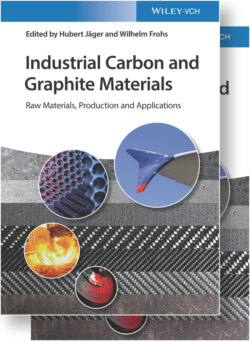Читать книгу Industrial Carbon and Graphite Materials - Группа авторов - Страница 259
Оглавление6.1 Introduction to Polygranular Carbon and Graphite Materials
The basic principles for modern metal production were developed during the industrial revolution in the eighteenth century. Blast furnaces for iron reduction grew in size and efficiency, and carbon blocks were introduced as lining material. As electric current became widely available, electrochemical reduction processes were expanded to industrial scale. Hall and Héroult independently developed the aluminum electrolysis process that is still used today to melt metallic ores and aluminum scrap. As a result, the demand for synthetic graphite significantly increased. The electrical graphitization processes invented by Acheson [1] and Caster [2] were able to satisfy the growing demand in synthetic graphite.
The growing utilization of carbon and graphite results from the unique physical and chemical properties that can be achieved within these materials. The most important properties are the high electrical and thermal conductivities, which resemble that of metals. Graphite materials also withstand high thermal shock loads due to the favorable combination of thermal conductivity, thermal expansion, and mechanical properties. Graphite does not melt under standard technical pressures and is resistant even to temperatures above 3300 K. It is only oxidation that limits the application of uncoated graphite materials in air to below 800 K. Graphite is highly resistant to chemicals, which opened up applications in corrosive media. Carbon and graphite properties can be altered widely by the types of raw material used, their combinations, and the applied process technology.
References
1 1 Acheson, E.G. (1895). US Patent 5,68,323.
2 2 Castner, J.H. (1893). GB 19089.
